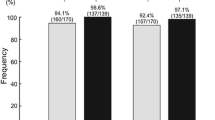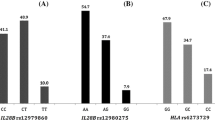Abstract
Background
Older patients with chronic hepatitis C have a lower virological response to interferon (IFN) treatment compared to younger patients. The efficacy of telaprevir (TVR) and PEG-IFN plus ribavirin combination therapy and the predictive value of recently identified IFN lambda (IFNL) 4 polymorphisms on the outcome of therapy for older patients have not been addressed.
Methods
We assessed predictive factors for sustained virological response (SVR) to triple therapy in 226 younger (≤65 years) and 87 older (>65 years) Japanese patients with chronic genotype 1 hepatitis C. IFNL4 polymorphism ss469415590 was analyzed by Invader assay.
Results
The SVR rate for older patients was slightly lower than for younger patients (69 vs. 82 %, P = 0.043). In the older group, the SVR rate for patients with the IFNL4 TT/TT genotype was significantly higher than patients with TT/ΔG or ΔG/ΔG genotypes (81.8 and 42.9 %, P = 0.003). In multivariate regression analysis, rapid virological response (OR 36.601, P = 0.002) and IFNL4 TT/TT genotype (OR 19.502, P = 0.009) were identified as significant independent predictors for SVR in older patients. Treatment-related decreases in hemoglobin and increases in serum creatinine were higher in older patients than younger patients. Reduction of initial TVR dose to 1,500 mg per day alleviated these adverse events without compromising SVR rate in older patients.
Conclusions
Analysis of IFNL4 polymorphisms is a valuable predictor in older patients receiving TVR triple therapy. 1,500 mg per day is a suitable initial TVR dose for older Japanese patients.




Similar content being viewed by others
References
NIH. National Institutes of Health Consensus Development Conference Statement. Management of hepatitis C 2002 (June 10–12, 2002). Gastroenterology. 2002;123:2082–99.
Seeff LB, Buskell-Bales Z, Wright EC, et al. Long-term mortality after transfusion-associated non-A, non-B hepatitis. N Engl J Med. 1992;327:1906–11.
Ogawa E, Furusyo N, Kajiwara E, et al. Efficacy of pegylated interferon alpha-2b and ribavirin treatment on the risk of hepatocellular carcinoma of patients with chronic hepatitis C: a prospective, multicenter study. J Hepatol. 2013;58:495–501.
Tanaka Y, Hanada K, Mizokami M, et al. A comparison of the molecular clock of hepatitis C virus in the United States and Japan predicts that hepatocellular carcinoma incidence in the United States will increase over the next two decades. Proc Natl Acad Sci USA. 2002;99:15584–9.
Lee SS, Heathcote EJ, Reddy KR, et al. Prognostic factors and early predictability of sustained viral response with peginterferon alfa-2a (40 KD). J Hepatol. 2002;37:500–6.
Zeuzem S. Heterogeneous virologic response rates to interferon-based therapy in patients with chronic hepatitis C: who responds less well. Ann Intern Med. 2004;140:370–81.
Kainuma M, Furusyo N, Kajiwara E, et al. Kyushu University Liver Disease Study Group pegylated interferon a-2b plus ribavirin for older patients with chronic hepatitis C. World J Gastroenterol. 2010;16:4400–9.
Iwasaki Y, Ikeda H, Araki Y, et al. Limitation of combination therapy of interferon and ribavirin for older patients with chronic hepatitis C. Hepatology. 2006;43:54–63.
Hiramatsu N, Oze T, Tsuda N, et al. Should aged patients with chronic hepatitis C be treated with interferon and ribavirin combination therapy. Hepatol Res. 2006;35:185–9.
McHutchison JG, Everson GT, Gordon SC, PROVE1 Study Team, et al. Telaprevir with peginterferon and ribavirin for chronic HCV genotype 1 infection. N Engl J Med. 2009;360:1827–38.
Jacobson IM, McHutchison JG, Dusheiko G, et al. Telaprevir for previously untreated chronic hepatitis C virus infection. N Engl J Med. 2011;364:2405–16.
Kumada H, Toyota J, Okanoue T, et al. Telaprevir with peginterferon and ribavirin for treatment-naive patients chronically infected with HCV of genotype 1 in Japan. J Hepatol. 2012;56:78–84.
Hayashi N, Okanoue T, Tsubouchi H, et al. Efficacy and safety of telaprevir, a new protease inhibitor, for difficult-to-treat patients with genotype 1 chronic hepatitis C. J Viral Hepat. 2012;19:e134–42.
Chayama K, Hayes CN, Ohishi W, et al. Treatment of chronic hepatitis C virus infection in Japan: update on therapy and guidelines. J Gastroenterol. 2013;48:1–12.
Furusyo N, Ogawa E, Nakamuta M, et al. Telaprevir can be successfully and safely used to treat older patients with genotype 1b chronic hepatitis C. J Hepatol. 2013;59:205–12.
Ge D, Fellay J, Thompson AJ, et al. Genetic variation in IL28B predicts hepatitis C treatment-induced viral clearance. Nature. 2009;461:399–401.
Tanaka Y, Nishida N, Sugiyama M, et al. Genome-wide association of IL28B with response to pegylated interferon-alpha and ribavirin therapy for chronic hepatitis C. Nat Genet. 2009;41:1105–9.
Suppiah V, Moldovan M, Ahlenstiel G, et al. IL28B is associated with response to chronic hepatitis C interferon-alpha and ribavirin therapy. Nat Genet. 2009;41:1100–4.
Nishiguchi S, et al. Relevance of the Core 70 and IL-28B polymorphism and response-guided therapy of peginterferon alfa-2a ± ribavirin for chronic hepatitis C of Genotype 1b: a multicenter randomized trial. ReGIT-J study. J Gastroenterol. 2013;. doi:10.1007/s00535-013-0785-2.
Akuta N, Suzuki F, Hirakawa M, et al. Amino acid substitution in hepatitis C virus core region and genetic variation near the interleukin 28B gene predict viral response to telaprevir with peginterferon and ribavirin. Hepatology. 2010;52:421–9.
Chayama K, Hayes CN, Abe H, et al. IL28B but not ITPA polymorphism is predictive of response to pegylated interferon, ribavirin, and telaprevir triple therapy in patients with genotype 1 hepatitis C. J Infect Dis. 2011;204:84–93.
Prokunina-Olsson L, Muchmore B, Tang W, et al. A variant upstream of IFNL3 (IL28B) creating a new interferon gene IFNL4 is associated with impaired clearance of hepatitis C virus. Nat Genet. 2013;45:164–71.
Akuta N, Suzuki F, Kawamura Y, et al. Predictive factors of early and sustained responses to peginterferon plus ribavirin combination therapy in Japanese patients infected with hepatitis C virus genotype 1b: amino acid substitutions in the core region and low-density lipoprotein cholesterol levels. J Hepatol. 2007;46:403–10.
Akuta N, Suzuki F, Sezaki H, et al. Predictive factors of virological non-response to interferon-ribavirin combination therapy for patients infected with hepatitis C virus of genotype 1b and high viral load. J Med Virol. 2006;78:83–90.
Fellay J, Thompson A, Ge D, et al. ITPA gene variants protect against anaemia in patients treated for chronic hepatitis C. Nature. 2010;464:405–8.
Ochi H, Maekawa T, Abe H, et al. ITPA polymorphism affects ribavirin-induced anemia and outcomes of therapy-a genome-wide study of Japanese HCV virus patients. Gastroenterology. 2010;139:1190–7.
Suzuki F, Suzuki Y, Akuta N, et al. Influence of ITPA polymorphisms on decreases of hemoglobin during treatment with pegylated interferon, ribavirin, and telaprevir. Hepatology. 2011;53:415–21.
Ohnishi Y, Tanaka T, Ozaki K, et al. A high-throughput SNP typing system for genome-wide association studies. J Hum Genet. 2001;46:471–7.
Suzuki A, Yamada R, Chang X, et al. Functional haplotypes of PADI4, encoding citrullinating enzyme peptidylarginine deiminase 4, are associated with rheumatoid arthritis. Nat Genet. 2003;34:395–402.
Arase Y, Ikeda K, Suzuki F, et al. Long-term outcome after interferon therapy in elderly patients with chronic hepatitis C. Intervirology. 2007;50:16–23.
Huang CF, Yang JF, Dai CY, et al. Efficacy and safety of pegylated interferon combination with ribavirin for the treatment of older patients with chronic hepatitis C. J Infect Dis. 2010;201:751–9.
Honda T, Katano Y, Shimizu J, et al. Efficacy of peginterferon-alpha-2b plus ribavirin in patients aged 65 years and older with chronic hepatitis C. Liver Int. 2010;30:527–37.
Reesink HW, Zeuzem S, Weegink CJ, et al. Rapid decline of viral RNA in hepatitis C patients treated with VX-950: a phase Ib, placebo-controlled, randomized study. Gastroenterology. 2006;131:997–1002.
Suzuki F, Suzuki Y, Sezaki H, et al. Exploratory study on telaprevir given every 8 h at 500 mg or 750 mg with peginterferon-alpha-2b and ribavirin in hepatitis C patients. Hepatol Res. 2013;43:691–701. doi:10.1111/hepr.12009.
Acknowledgments
This work was supported by Grants-in-Aid for scientific research and development from the Ministry of Health, Labor and Welfare and the Ministry of Education, Culture, Sports, Science, and Technology, Government of Japan. The funders had no role in the study's design, data collection and analysis, the decision to publish, or preparation of the manuscript. No additional external funding was received for this study.
The authors thank the other members of the SNP Research Center for assistance with various aspects of this study. Part of this work was carried out at the Analysis Center of Life Science, Hiroshima University. Hiroshima Liver Study Group. Members of the Hiroshima Liver Study Group (listed in alphabetical order) include Shiomi Aimitsu (Hiroshima General Hospital of West Japan Railway Company, Hiroshima, Japan), Yasuyuki Aisaka (Hiroshima Red Cross Hospital, Hiroshima, Japan), Hajime Amano (Onomichi General Hospital, Hiroshima, Japan), Tatsuya Amimoto (Amimoto Clinic, Hiroshima, Japan), Keiko Arataki (Hiroshimakinen Hospital, Hiroshima, Japan), Nobuyuki Asada (Asada Clinic, Hiroshima, Japan), Takahiro Azakami (Miyoshi Cyuo Hospital, Hiroshima, Japan), Kunio Ishida (Hiroshima General Hospital, Hiroshima, Japan), Hiroto Ishihara (Hiroshima-Nishi Medical Center, Hiroshima, Japan), Tomokazu Ishitobi (Hiroshima Chuden Hospital, Hiroshima, Japan), Hiroyuki Ito (Saiseikai Kure Hospital, Hiroshima, Japan), Koji Kamada (Shobara Red Cross Hospital, Hiroshima, Japan), Masaya Kamiyasu (Kamiyasu Clinic, Hiroshima, Japan), Hiroiku Kawakami (Kawakami Clinic, Hiroshima, Japan), Shinsuke Kira (Saiseikai Hiroshima Hospital, Hiroshima, Japan), Mikiya Kitamoto (Hiroshima Prefectural Hospital, Hiroshima, Japan), Hideaki Kodama (Hiroshima Kinen Hospital, Hiroshima, Japan), Hiroshi Kohno (Kure Medical Center, Hiroshima, Japan), Hirotaka Kohno (Kure Medical Center, Hiroshima, Japan), Toshiyuki Masanaga (Masanaga Clinic, Hiroshima, Japan), Toshio Miura (Akitsu Prefectural Hospital, Hiroshima, Japan), Nami Mori (Hiroshima Red Cross Hospital, Hiroshima, Japan), Takashi Moriya (Chugoku Rousai Hospital, Hiroshima, Japan), Yutaka Nabeshima (Chuden Hospital, Hiroshima, Japan), Yuko Nagaoki (Higashihiroshima Medical Center, Hiroshima, Japan), Toshio Nakamura (Nakamura Clinic, Hiroshima, Japan), Toshio Nakanishi (Miyoshi Cyuo Hospital, Hiroshima, Japan), Ryo Nakashio (Nakashio Clinic, Hiroshima, Japan), Michihiro Nonaka (Hiroshima General Hospital, Hiroshima, Japan), Makoto Ohbayashi (Onomichi General Hospital, Hiroshima, Japan), Shintaro Takaki (Hiroshima Red Cross Hospital, Hiroshima, Japan), Eichi Takesaki (Higashihiroshima Medical Center, Hiroshima, Japan), Toru Tamura (Mazda Hospital, Hiroshima, Japan), Keiji Tsuji (Hiroshima City Asa Hospital, Hiroshima, Japan), Koji Waki (Hiroshima City Asa Hospital, Hiroshima, Japan), Masashi Watanabe (Kuchiwa Clinic, Hiroshima, Japan), Syuji Yamaguchi (Kure Kyosai Hospital, Hiroshima, Japan), Keitaro Yamashina (Hiroshima General Hospital of West Japan Railway Company, Hiroshima, Japan).
Conflict of interest
K Chayama received research grants from MSD K.K., Chugai Pharmaceutical Co., Ltd., Bristol-Myers Squibb Company, Mitsubishi Tanabe Pharma Corporation, Dainippon Sumitomo Pharma Co., Ltd., DAIICHI SANKYO COMPANY, LIMITED, Meiji Seika Pharma Co., Ltd., and received lecture fees from MSD K.K., Chugai Pharmaceutical Co., Ltd., Bristol-Myers Squibb Company, Mitsubishi Tanabe Pharma Corporation, Dainippon Sumitomo Pharma Co., Ltd.
Author information
Authors and Affiliations
Consortia
Corresponding author
Rights and permissions
About this article
Cite this article
Fujino, H., Imamura, M., Nagaoki, Y. et al. Predictive value of the IFNL4 polymorphism on outcome of telaprevir, peginterferon, and ribavirin therapy for older patients with genotype 1b chronic hepatitis C. J Gastroenterol 49, 1548–1556 (2014). https://doi.org/10.1007/s00535-013-0924-9
Received:
Accepted:
Published:
Issue Date:
DOI: https://doi.org/10.1007/s00535-013-0924-9




